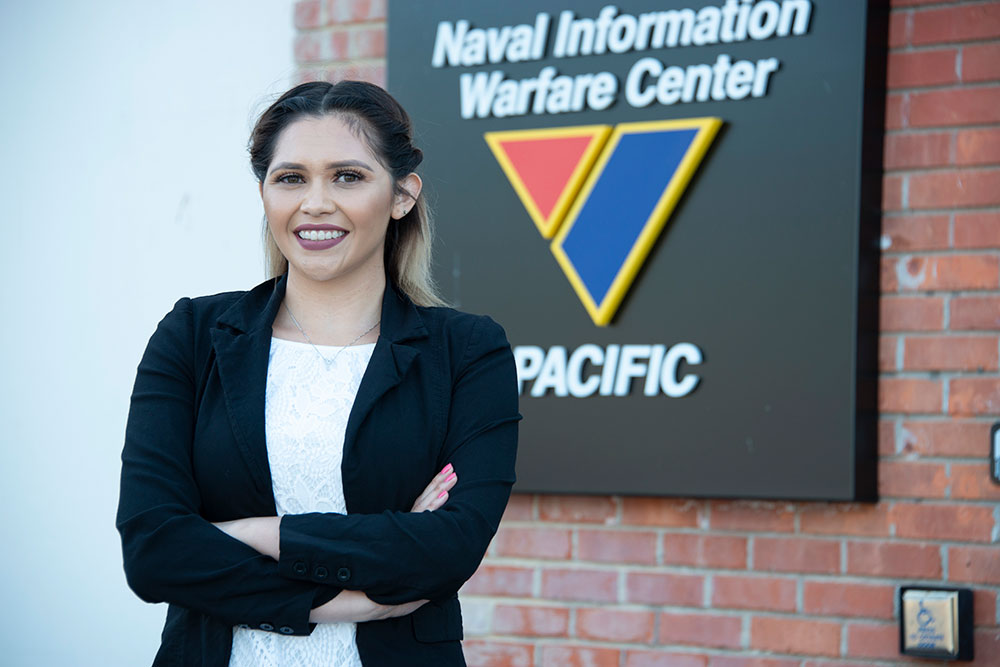San Diego City College graduate Froylan Maldonado can’t believe his good fortune. Even before he transfers to UCLA this fall to further his studies in computer science and mathematics, Maldonado has signed on to work with the San Diego-based Naval Information Warfare Systems Command, formerly known as SPAWAR, during breaks from school and once he graduates. He is one of 16 City College STEM students selected for an initial cohort taking part in a groundbreaking new partnership between Naval Information Warfare Systems and the San Diego Community College District in which the naval agency will provide opportunities for tuition assistance and career growth.
“When I heard about this program, I’m thinking they probably only want to target superstars, why are they looking at us community college students?” said Maldonado, 22, who was raised by a single mom. “It seemed too good to be true. The hardest part for any student is finding a job once you’re out of school. I already have one waiting for me when I graduate.”
With record-low unemployment and a shortage of trained industry professionals, Naval Information Warfare Systems officials say they must become more creative in building and sustaining their ranks. The company’s partnership with the SDCCD goes beyond City College and includes working with San Diego Continuing Education in offering certification programs aimed not only at expanding the skills of Naval Information Warfare Systems employees, but also training returning adult learners.
In addition, Naval Information Warfare Systems and the SDCCD’s Military Education arm will target military members returning to civilian life and wanting to learn about cloud computing, cryptology, network security, software development, and artificial intelligence — all with an eye on strengthening a pipeline of high-tech, STEM-centered employees. Additionally, the organization is looking at further expanding the program to include contractors.
The partnership also fits into a larger SDCCD vision of working with businesses and industries in order to provide students with more opportunities to find good paying careers.
“This is an example of organizations coming to us for help in creating a pipeline
of well-trained professionals and training of incumbent employees,” SDCCD Vice Chancellor
of Instructional Services Stephanie Bulger said. “They see us as a valuable partner
in workforce development.”
Addressing a Shortage
Naval Information Warfare Systems Command designs, develops, and maintains communication and information systems for the Navy. Its areas of expertise include cyberspace operations, space systems, air traffic control, and surveillance. At the core of its mission is cybersecurity, an area that is seeing a critical shortage of qualified professionals. According to a 2018 ISACA State of Cybersecurity report (ISACA is an acronym for the Information Systems Audit and Control Association), more than one in four respondents surveyed said it takes at least six months to fill a new cybersecurity position, and the industry is facing a shortage of nearly 3 million cybersecurity professionals worldwide.
San Diego County, meanwhile, is home to an estimated 8,500 cyber-related jobs, and Naval Information Warfare Systems is the largest employer of cybersecurity professionals in the region.
To address the shortage of qualified professionals, the San Diego Cyber Center of Excellence, California Cyberhub, the California Department of Industrial Relations — Division of Apprenticeship Standards, and Able-Disabled Advocacy began hosting a series of meetings in 2017 with employers, educational leaders, and others to explore possible solutions. That was followed in March 2018 by a meeting and roundtable discussion that included representatives from several community colleges from around the county.
“The San Diego Community College District saw an opportunity, took the initiative and ran with it,” said Lisa Easterly, chief operating officer at the San Diego Cyber Center of Excellence.
The template that was created from those talks included a STEM student’s dream: paid tuition, part-time work during the academic year, and full-time employment during the summer — culminating with full employment upon earning a bachelor’s or postgraduate degree.
“Imagine being a community college student and almost overnight knowing your path, knowing what your future will be, knowing what you’re going to do and where you’re going to work, and you haven’t even graduated yet,” said professor Rafael Alvarez, who heads City College’s Math, Engineering, Science Achievement (MESA) program.
The SDCCD, Naval Information Warfare Systems, and City College — most notably the City College Transfer/Career Center – spent months organizing a recruitment fair at the downtown campus to identify participants for the program’s initial cohort. On April 17, more than 30 City College students were granted interviews. The 16 who were recruited are undergoing security clearances, working with human resources specialists, and being assigned to specific projects.
“We have never done anything like this in the past,” said Angela Hanson, director of human resources for Naval Information Warfare Center (NIWC) Pacific, a division of Naval Information Warfare Systems Command. “We have never done a recruiting event at a community college before.”
Once a student becomes a Naval Information Warfare Systems employee, he or she is eligible for benefits that include a subsidized education. Meanwhile, students will be hired for positions paying up to $43,000 annually (working full time) while they go to school. Graduates with a bachelor’s degree can earn an initial annual salary of more than $73,000 with the potential of boosting that to more than $125,000 per year.

Yesenia Ponce was one of the initial 16 City College students selected. “It’s just unheard of,” said Ponce, a 24-year-old City Heights resident.
Majoring in electrical engineering, Ponce graduated in May with an associate degree for transfer in pre-engineering and mathematics. She was planning to enroll at Cal State Dominguez Hills this fall until she was tapped by Naval Information Warfare Systems. She plans to transfer to the University of San Diego next fall.
“This is huge,” Ponce said. “When you go to school, you don’t necessarily get any work experience. So to get this kind of an opportunity to work in a field you’d like to go into, and get a taste of what it’s like, is amazing. And then there’s a job waiting for you when you graduate with your bachelor’s degree? That’s just unbelievable.”
A Perfect Match
Why isn’t Naval Information Warfare Systems, which is also developing a partnership with San Diego Mesa and Miramar colleges, and Continuing Education, instead targeting a prestigious university to build its workforce?
“The ever-growing cybersecurity talent demand requires a continuum of skill sets and experience from recent graduates to transitioning service members to seasoned Ph.D.s,” Easterly said. “Hands-on, certificate and two-year degree programs are critical for bridging the gap and partnerships between academia and industry are key to ensuring the cyber workforce is prepared for the evolving cyber threat landscape.”
The impetus to work with local community colleges came from Jack Cabana, a native Chula Vistan who serves as Director of Corporate Operations for NIWC, Pacific. Cabana, said Hanson, is committed to providing opportunities for people from traditionally underserved communities, the same populations served by community colleges.
“It’s all part of giving back,” Hanson said.
Mimi Rosado, division head, Total Force Management at NIWC Pacific, emphasized that City College student employees will not be making coffee or answering the phones. “This is not an administrative internship,” she said. “We are giving these students meaningful work in their field alongside experts in the industry, which allows them to grow their experience before they graduate.”
Naval Information Warfare Systems officials concede there is some risk in hiring a community college student who may cut short his or her educational journey before earning even an associate degree. To cut down on that risk, Naval Information Warfare Systems will track students to make sure they’re adhering to their education plans. Students also must maintain a grade point average of 2.0 or higher, must be enrolled in at least six units, must be a U.S. citizen, must obtain and maintain a security clearance, and must be majoring in either science, technology, engineering, or mathematics.
“Our goal is to make sure they graduate because it’s a win for everyone” Rosado said.
City College graduate Maldonado has no doubt he will. After all, he will need an advanced degree to reach his dream of working as a software developer or mathematical modeler.
“My NIWC Pacific paperwork is being processed, I’m heading to UCLA, and I’m spending the summer in Pennsylvania doing research (via a National Science Foundation Grant),” Maldonado said. “It’s all pretty remarkable.”

